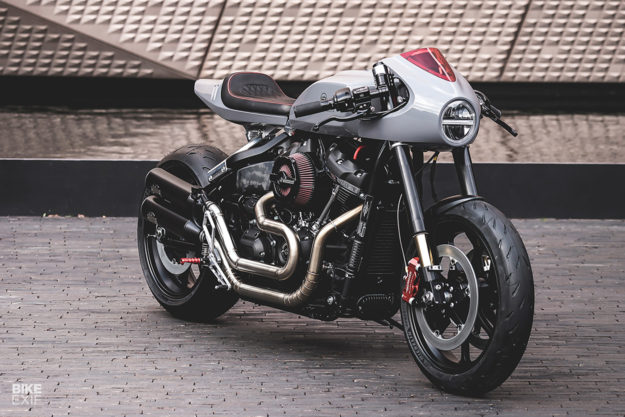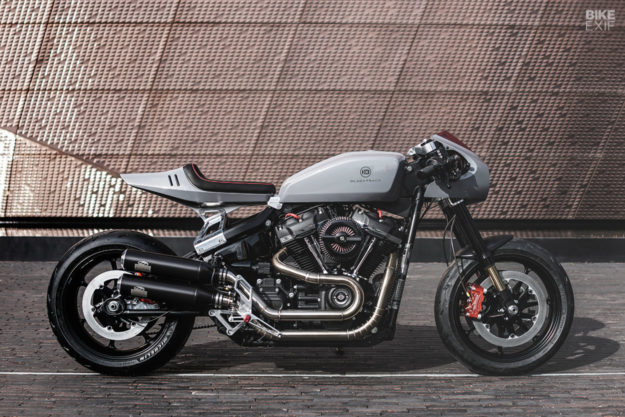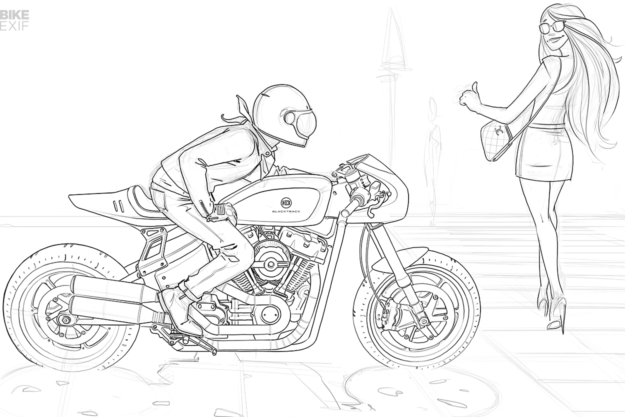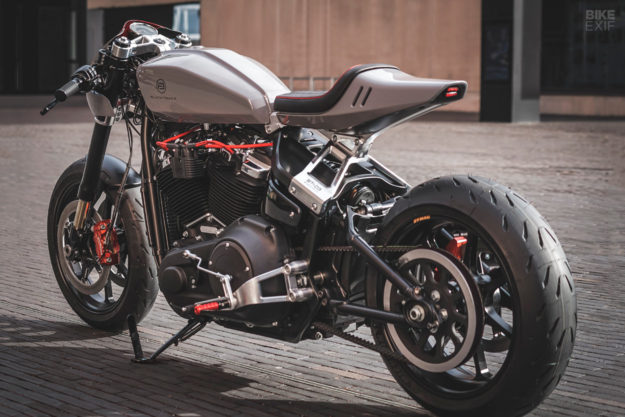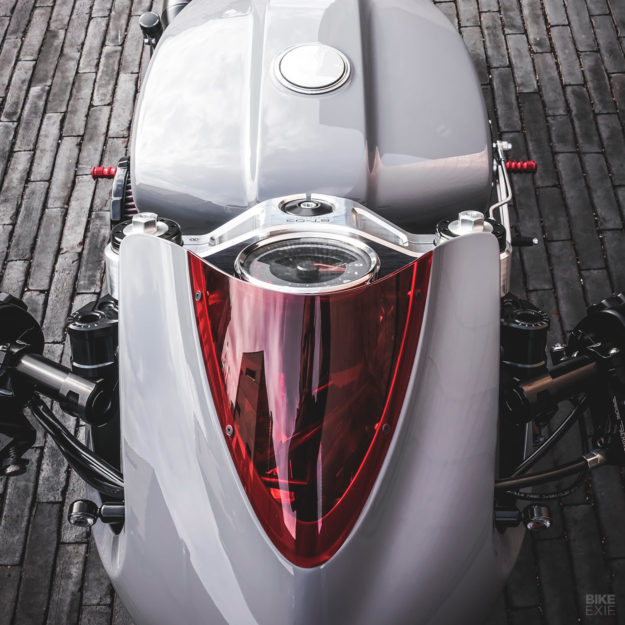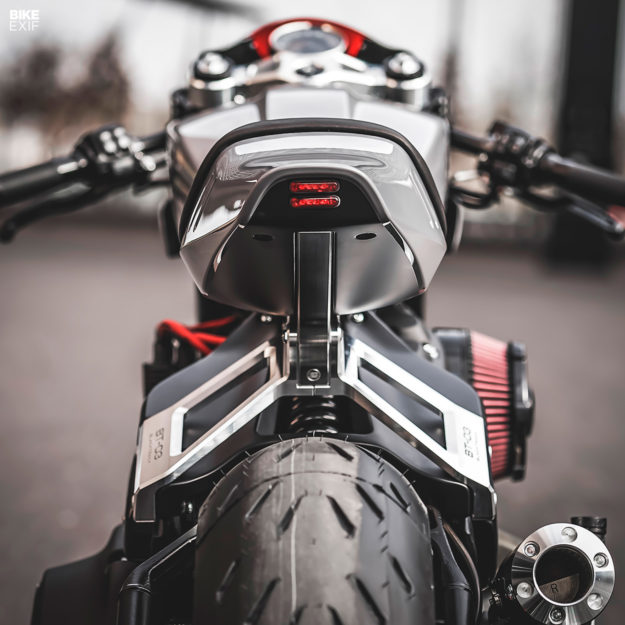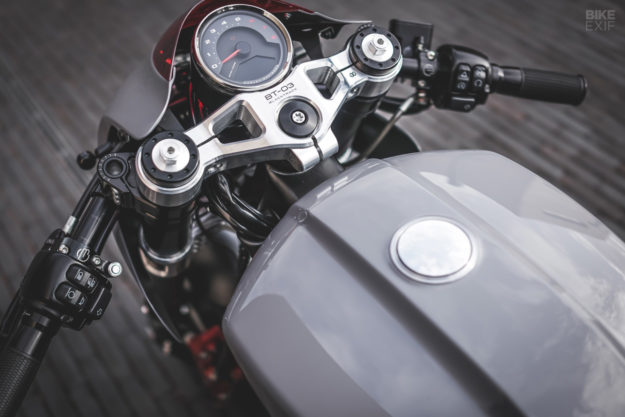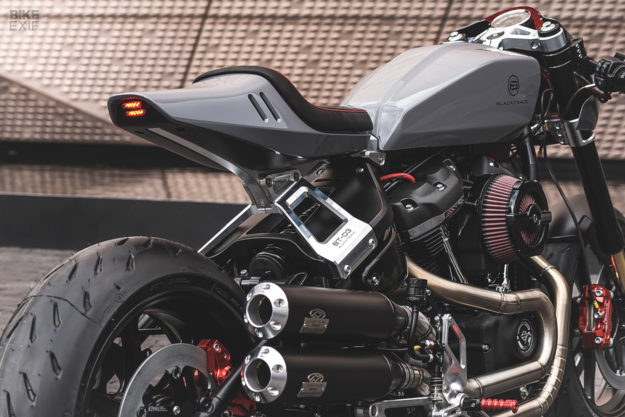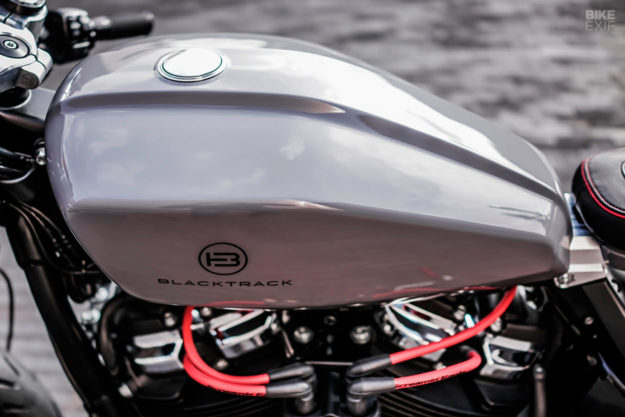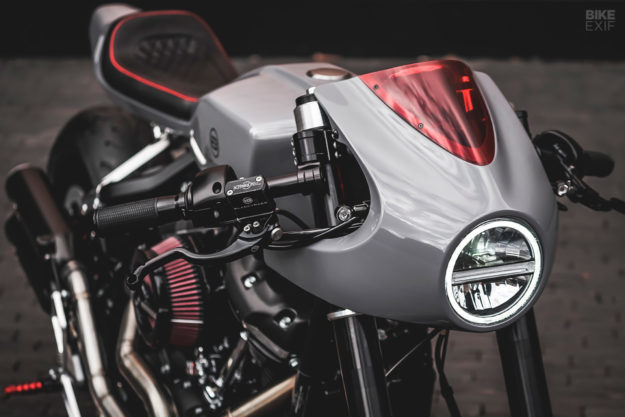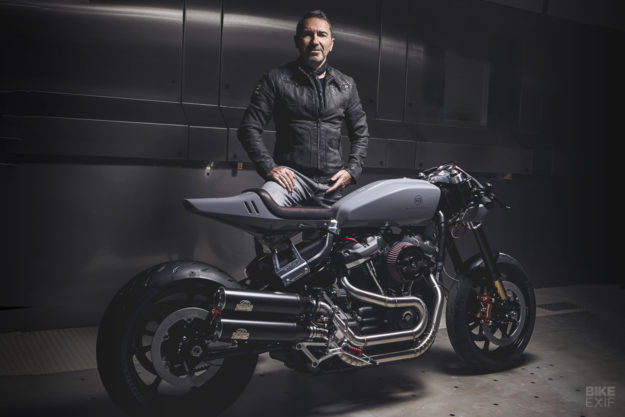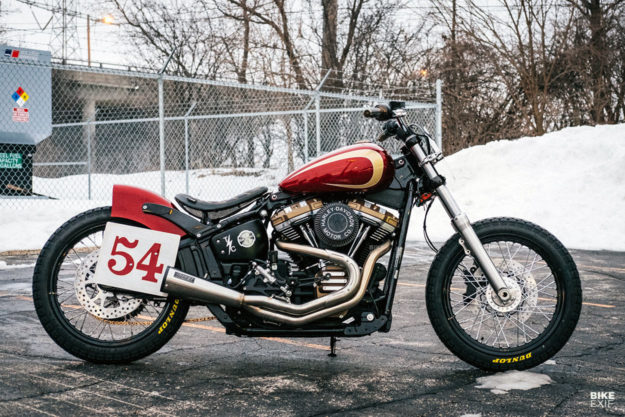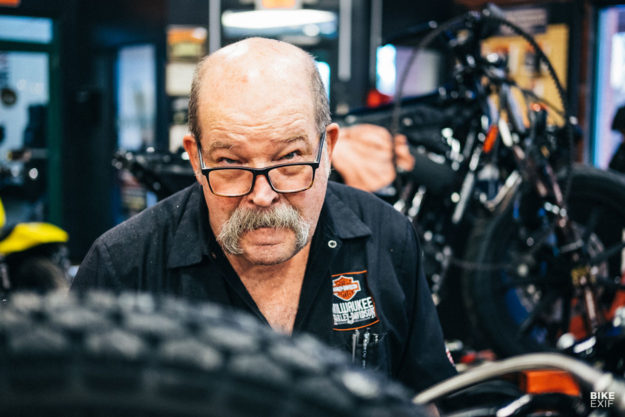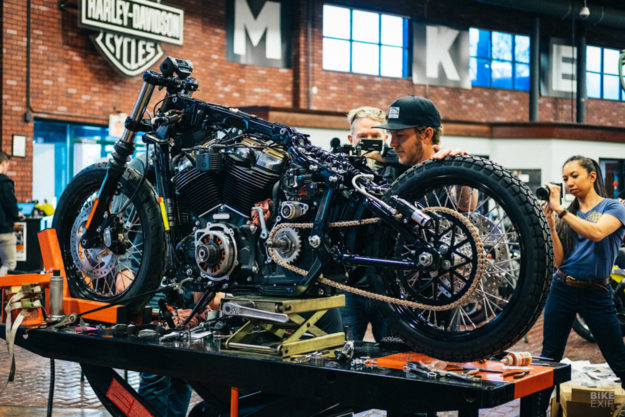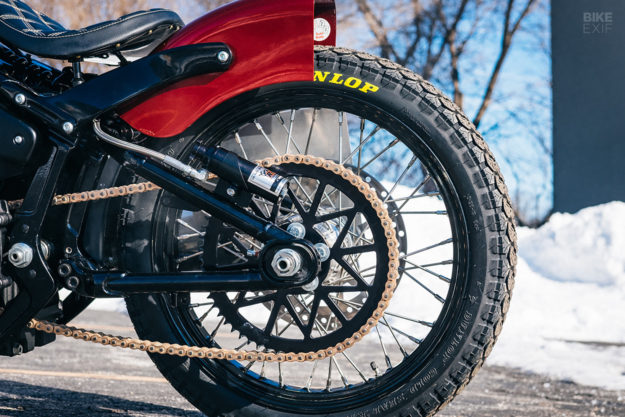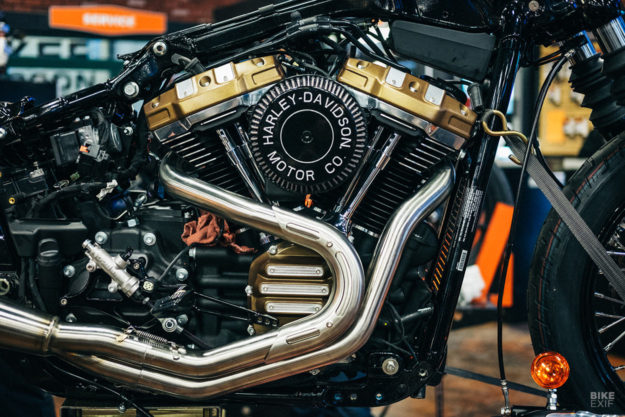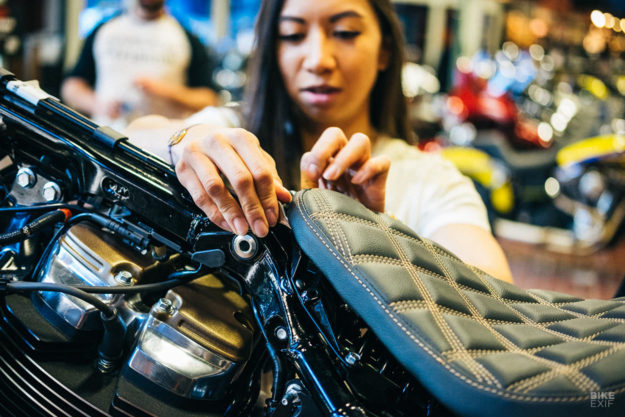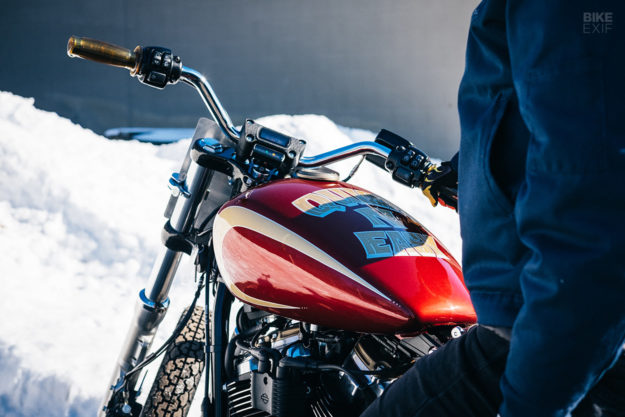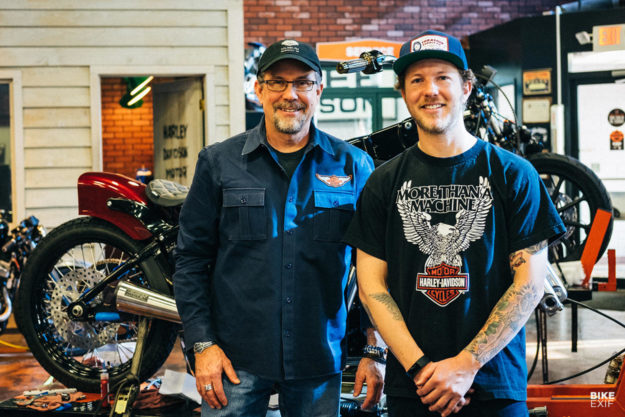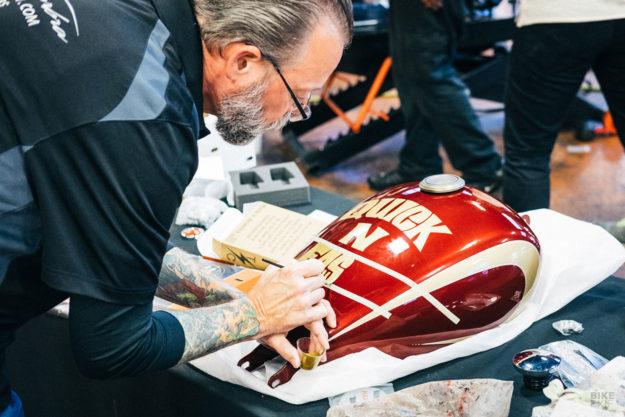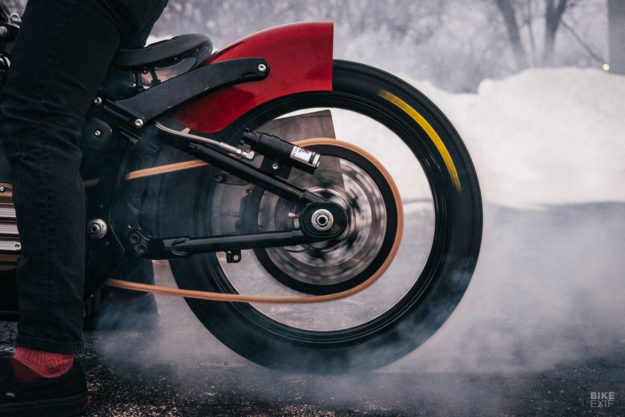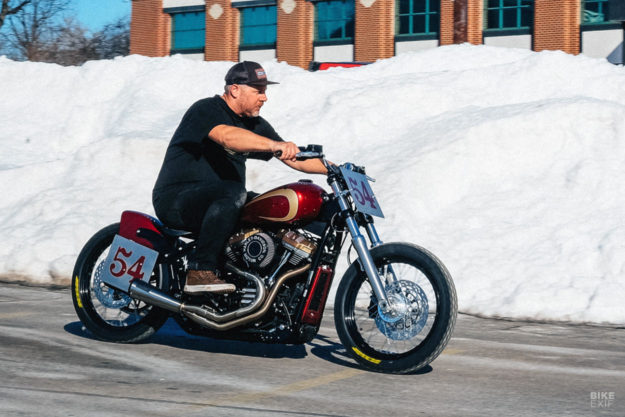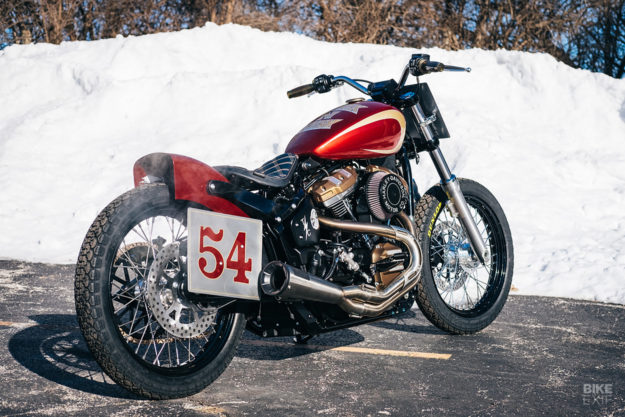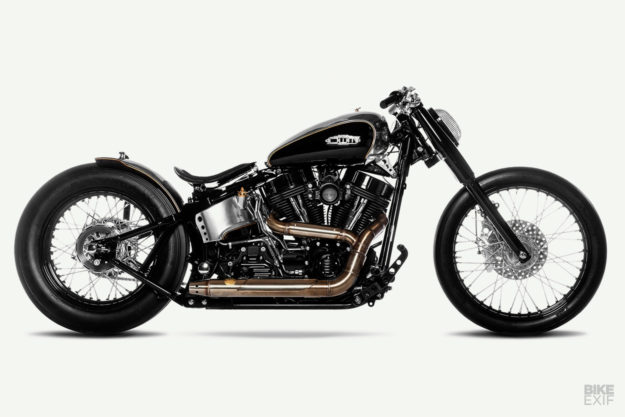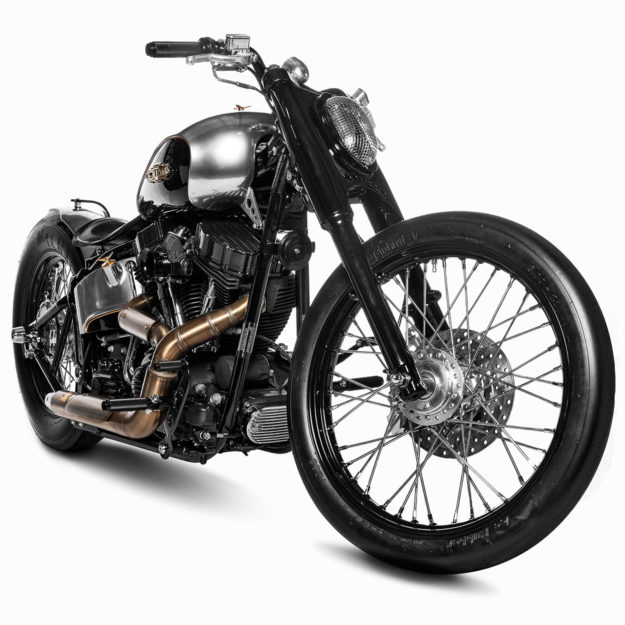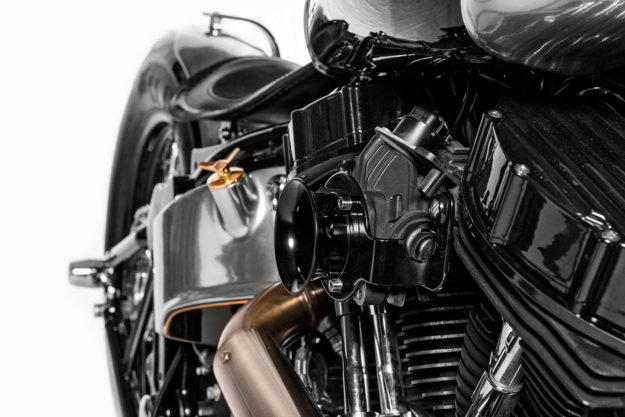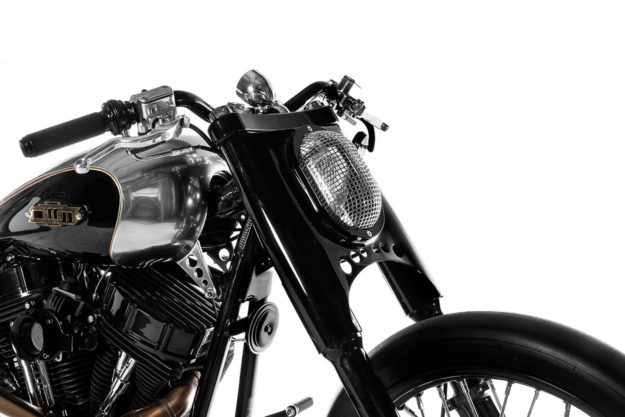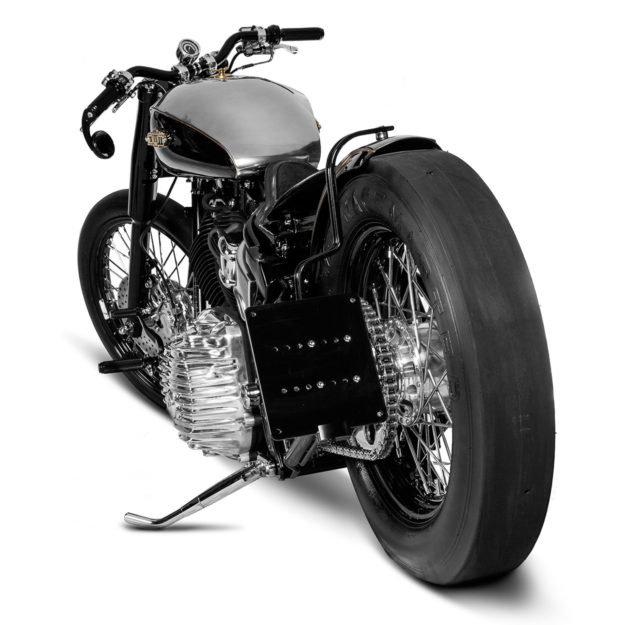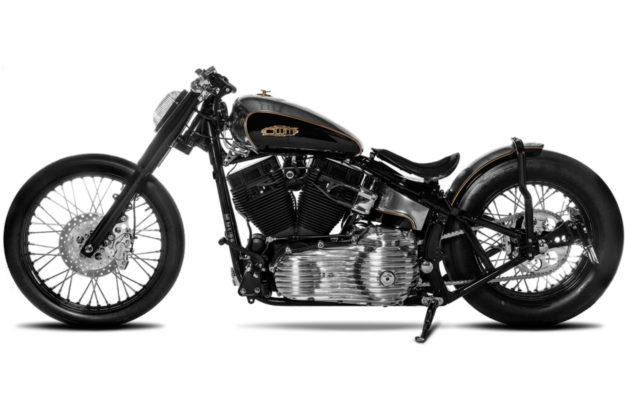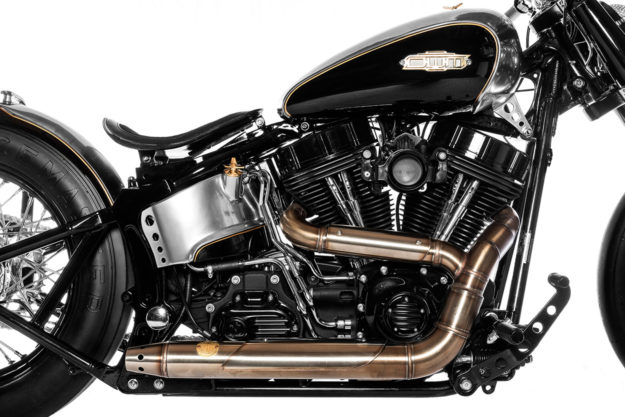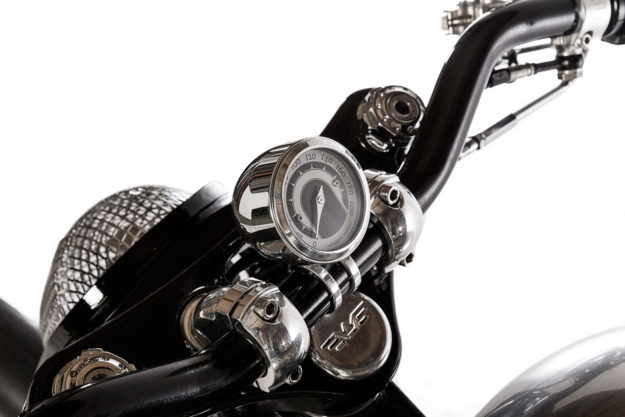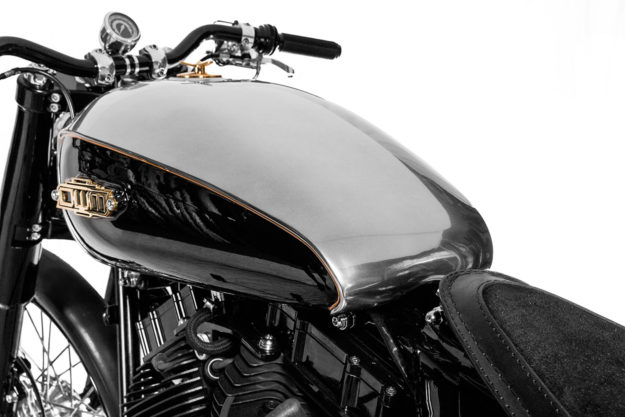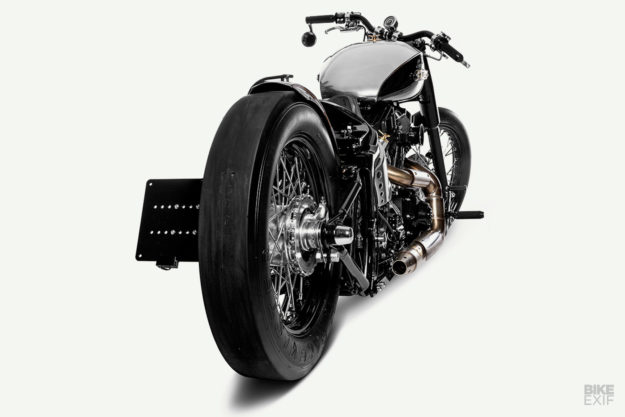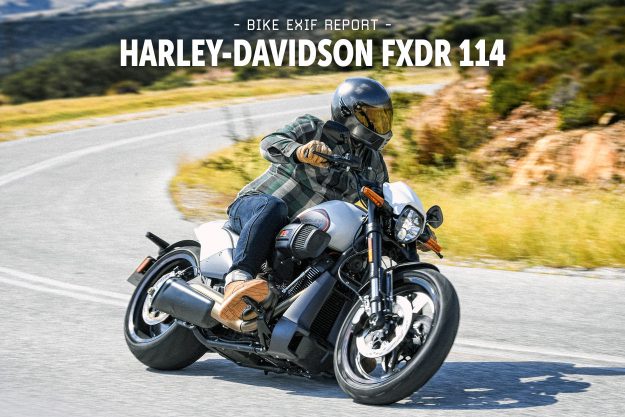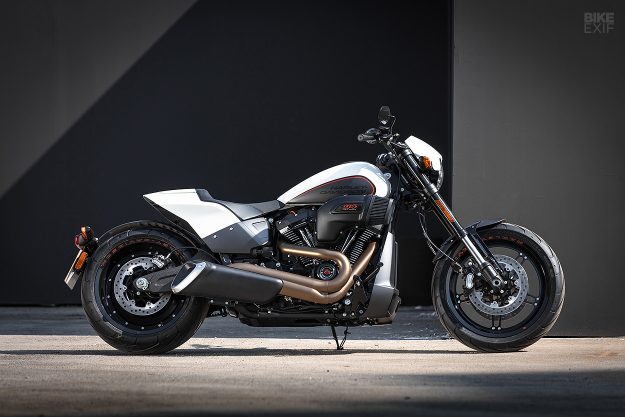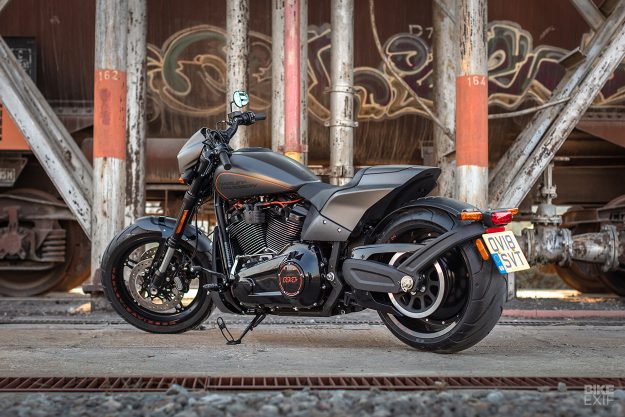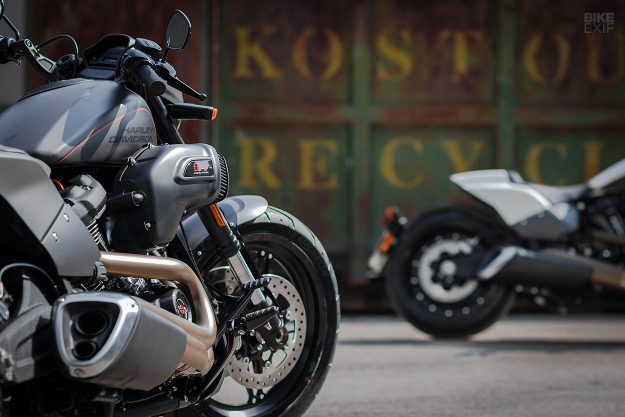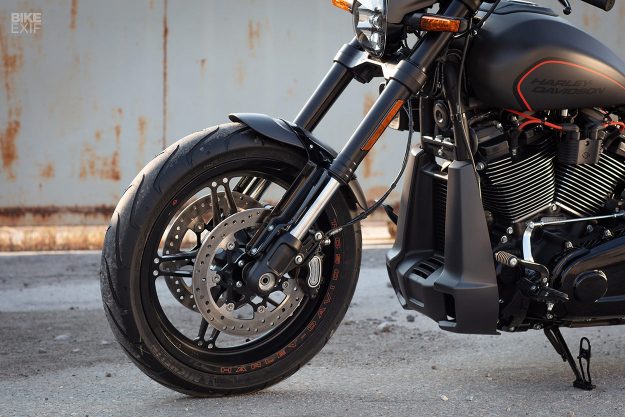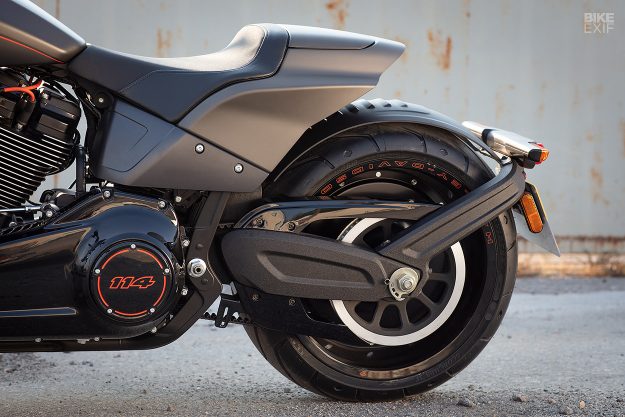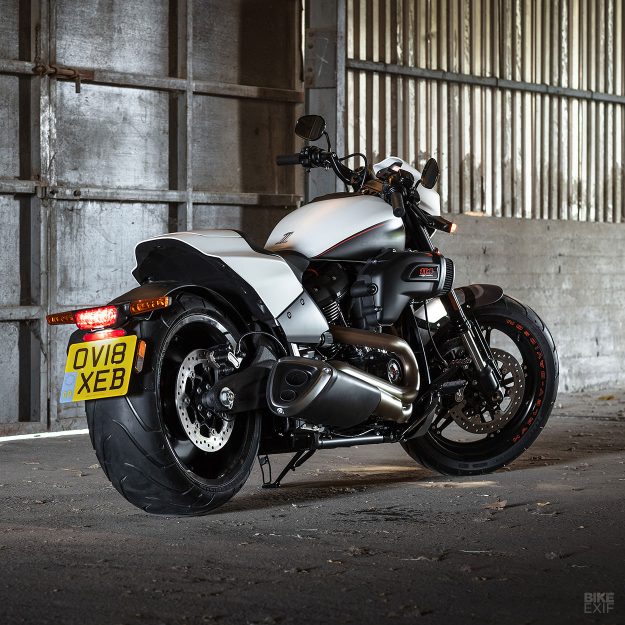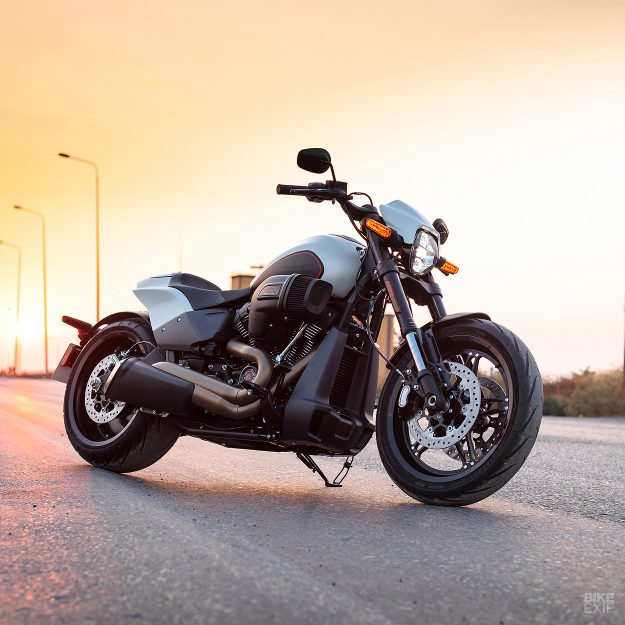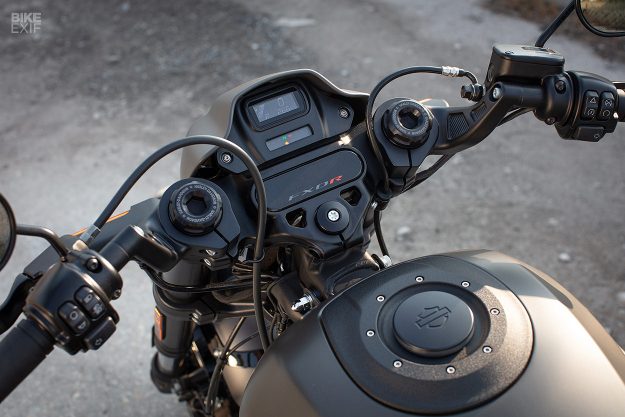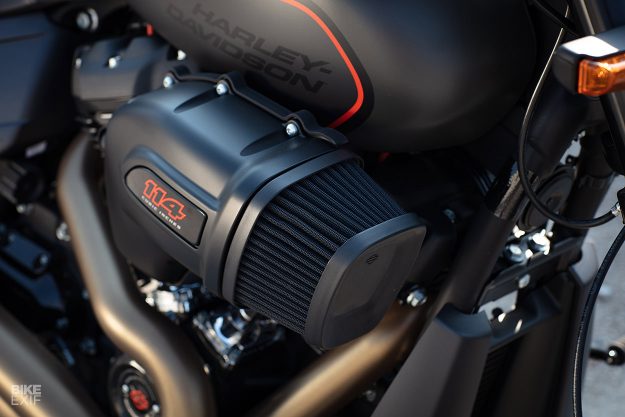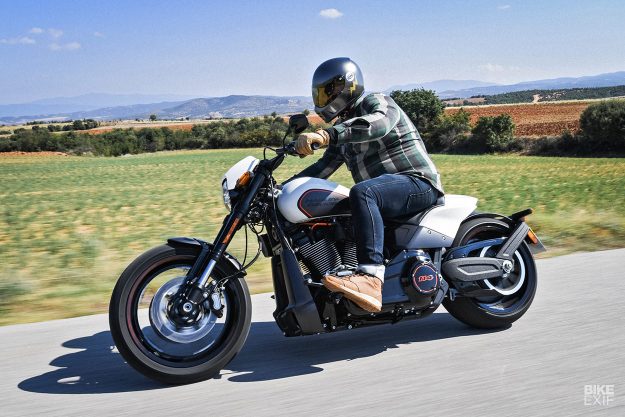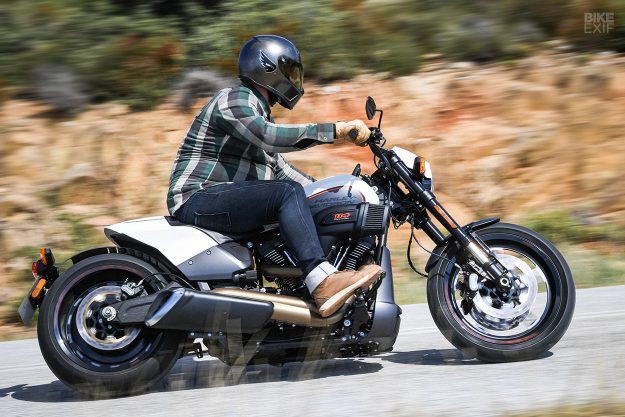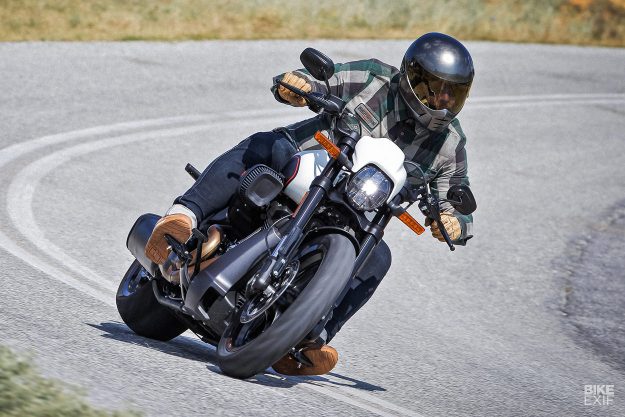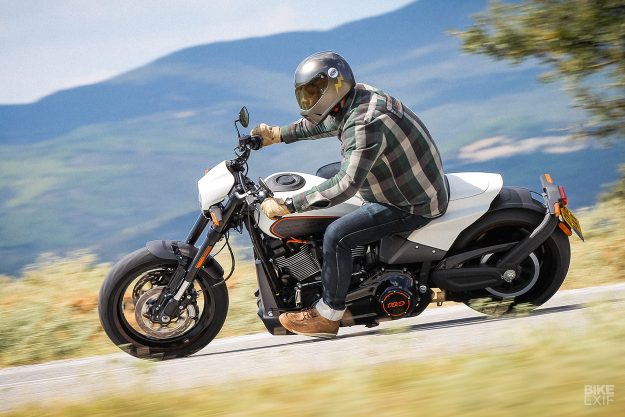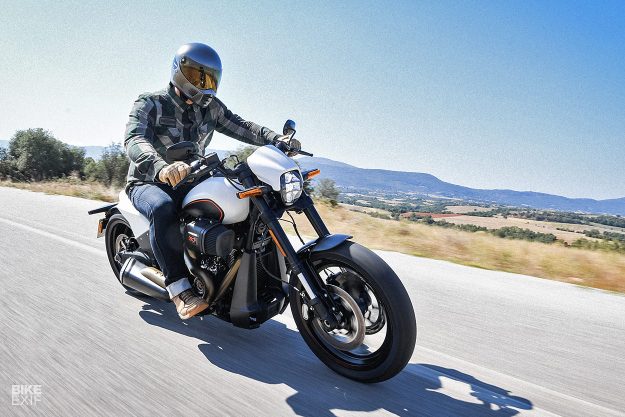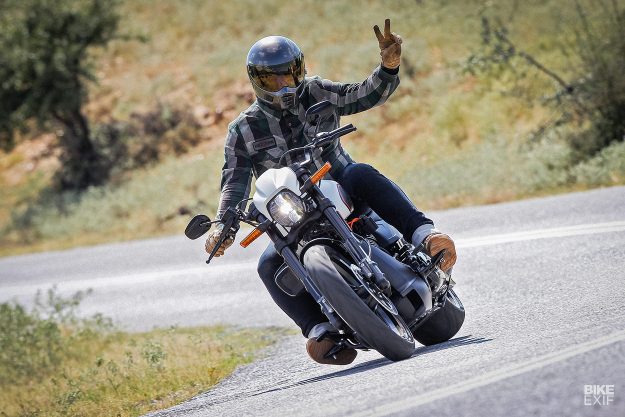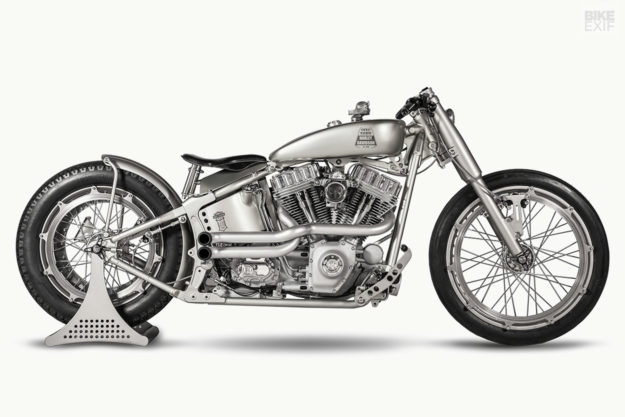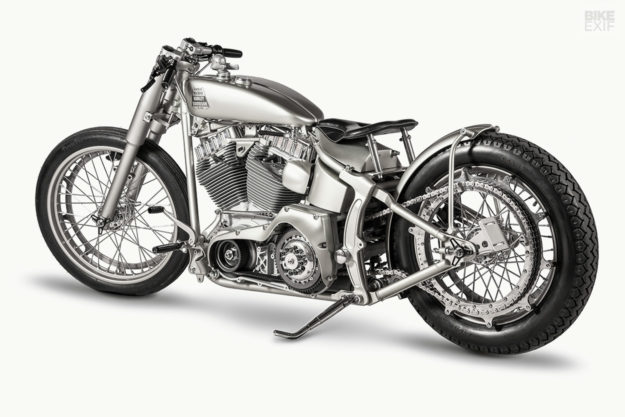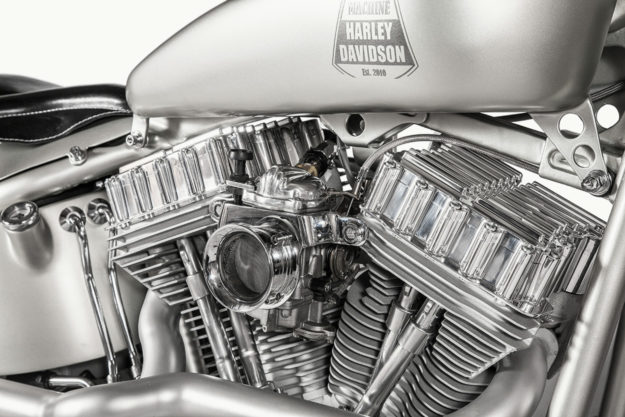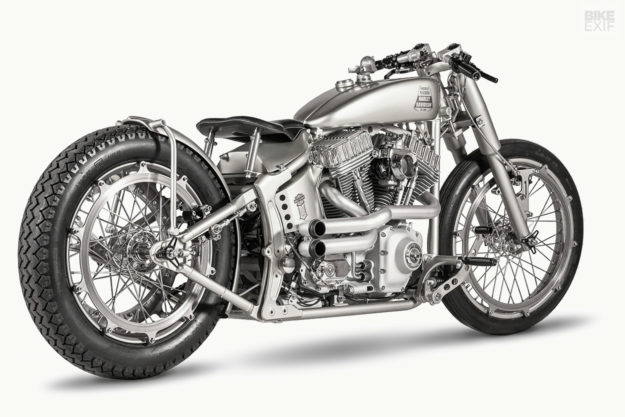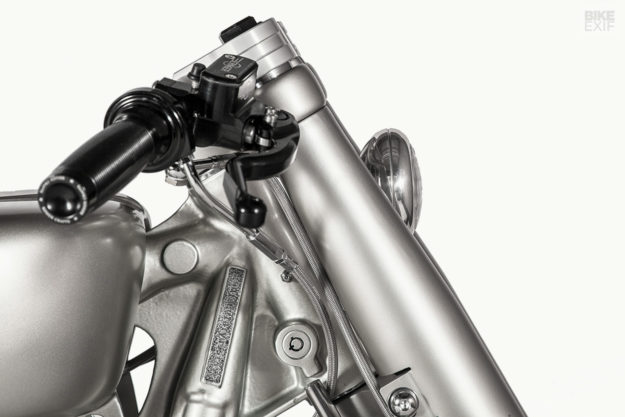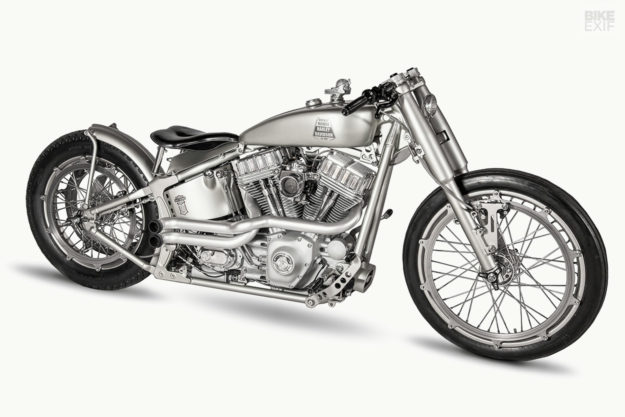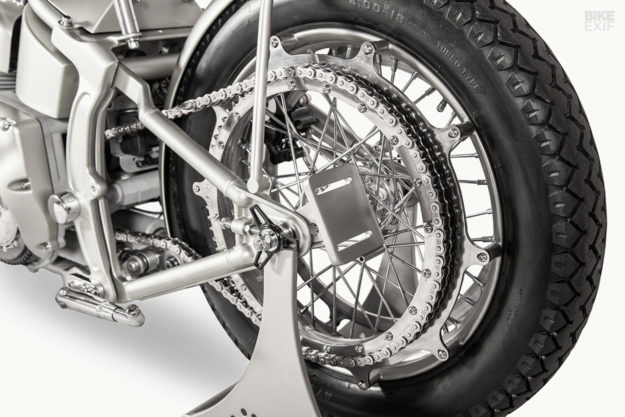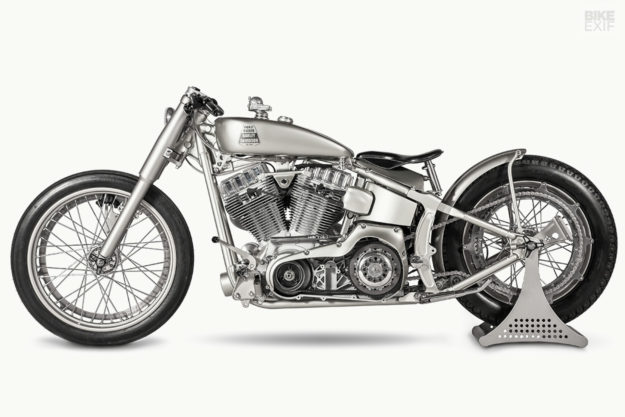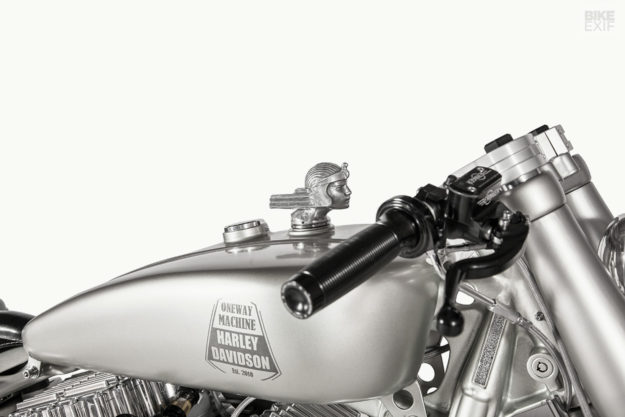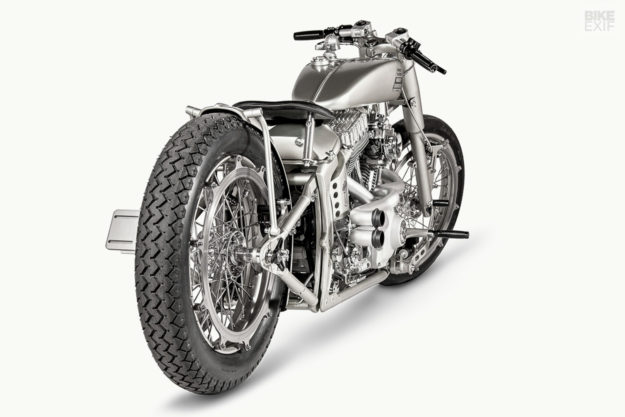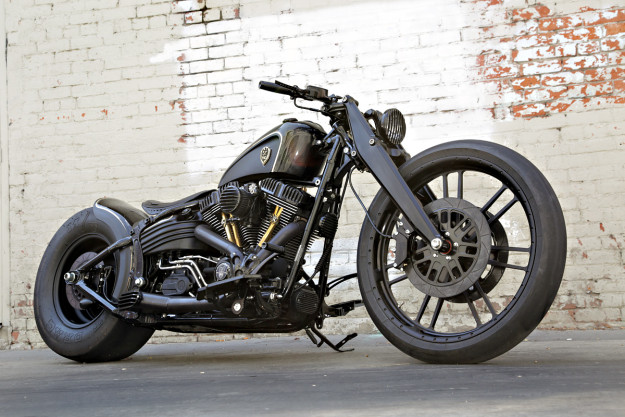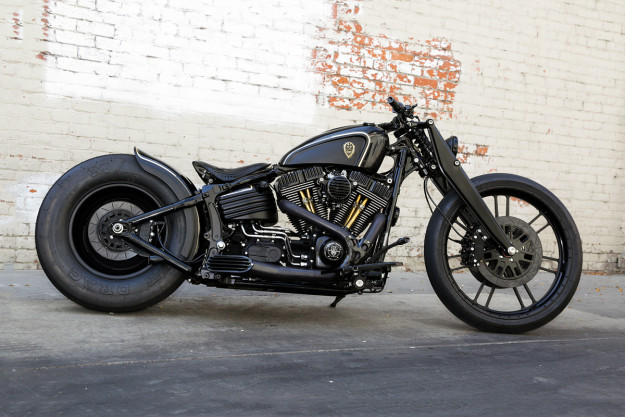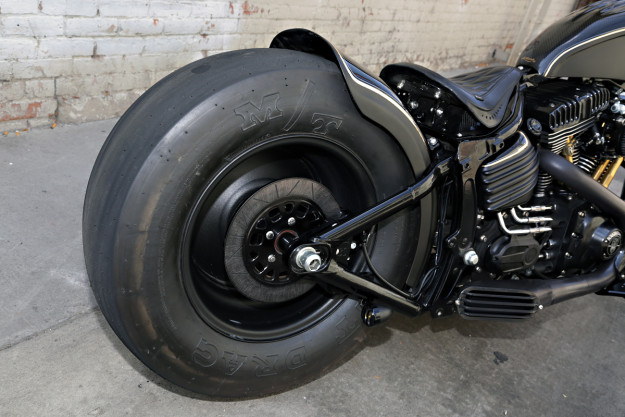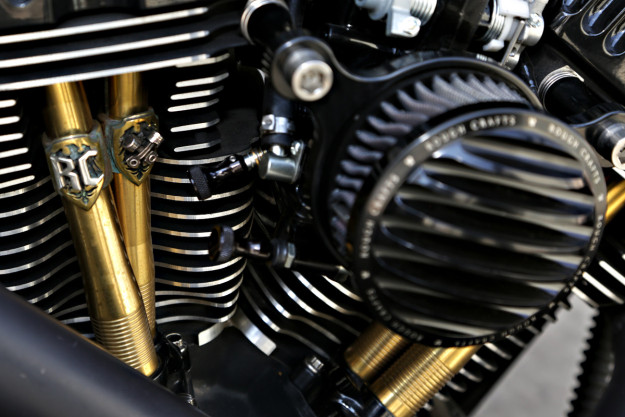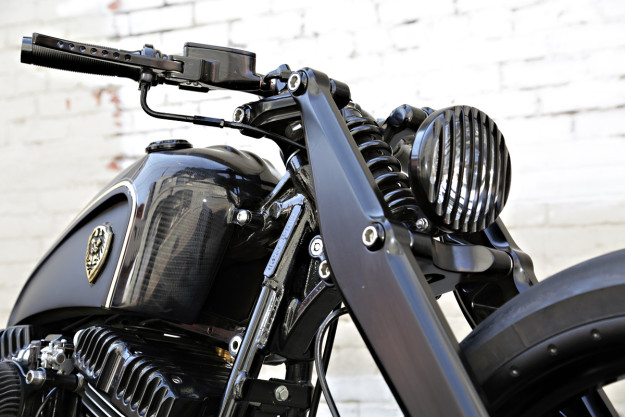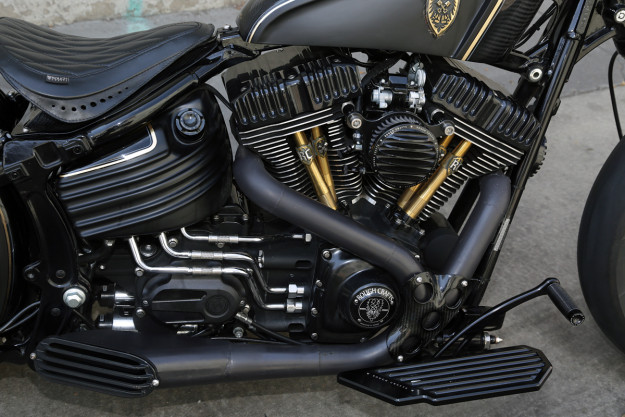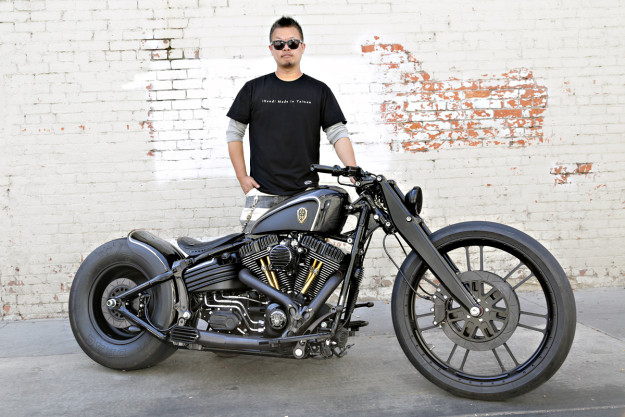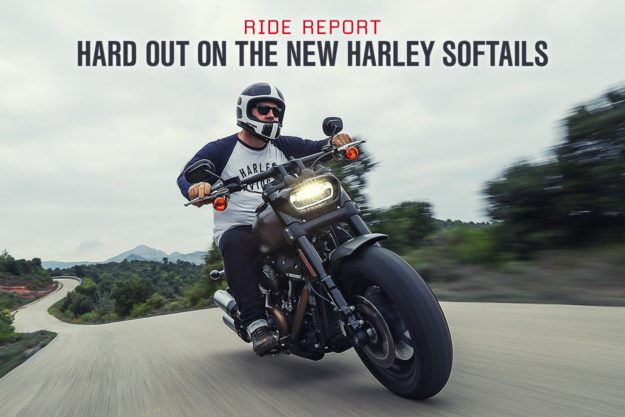
When Harley-Davidson announced its new Softail range, Dyna fans wept and shook their fists. Their beloved twin-shock platform was gone, with existing Dyna models absorbed into the eight-strong Softail model line-up.
It’s understandable—the Dyna was the go-to performance Harley for many riders. But if the new Softail rides better than the old Dyna, does it matter? To find out, I headed to Cataluña in the east of Spain, to sample the new range.
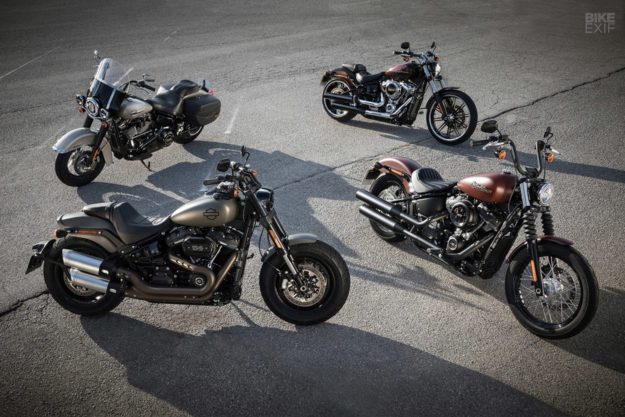
Rough Crafts‘ Winston Yeh rode the new bikes a few days before me. He said, “If you think the old Dyna rides better, wait ’til you get on a new Softail—then make the judgment.”
“The bike is lighter even when pushing it,” he continues. “The Softail is now only slightly heavier than a Sportster, but has much more power, less vibration, and less heat. I’m super excited to get my hands on one, and also to see what the custom shops all over the world will do with it.”
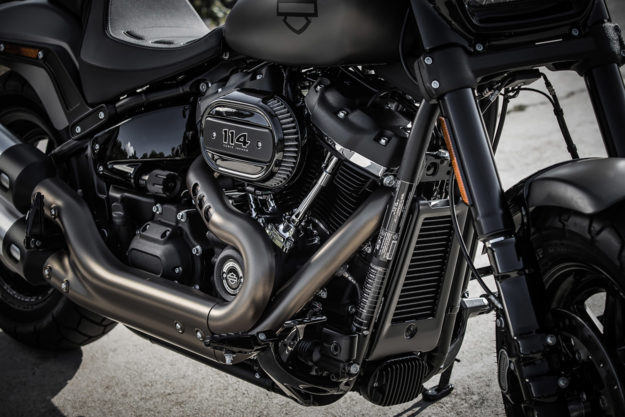
So how did the Motor Co. pull it off? Basically they’ve built an entirely new motorcycle—with a stiffer chassis and a better engine—and then morphed it into eight different variants. In ascending order of price, these are the Street Bob, Low Rider, Softail Slim, Fat Bob, Deluxe, Fat Boy, Heritage Classic and Breakout
The goal was to mesh all the classic appeal of the Softail with the performance aspect of the Dyna—but make it better than both in every way, with less weight, better handling and more power. It’s Harley’s largest product development project to date, and I have a fat PR pack in front of me explaining every little detail. But I’m going condense it down to the two most important bits: the chassis and the motor.

With its clothes off, the new Softail is a work of art. (See Street Bob, above and below.) It has the same faux hardtail layout as its predecessor, but with a conventional shock rather than the previous push/pull system. The geometry’s been revised too, but more importantly the frame is 65% stiffer than before, making the overall chassis 34% stiffer. Weight reductions vary, with some models shedding as much as 35 lbs.
Harley use two different swing arms—one for wide and one for narrower tires—and three different steering neck angles to tweak each model’s individual setup. The suspension is all-new too; the rear shock is adjustable for preload, and the front forks feature a ‘dual-bending’ valve system for a more responsive feel.
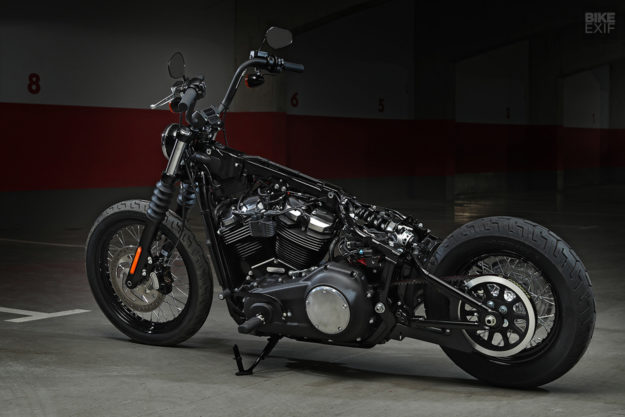
Powering the new Softail is Harley’s stellar Milwaukee-Eight power plant, available in two variants: 107 ci (1,746 cc) and 114 ci (1,868 cc). It’s a thing of beauty, and it’s a total gem to ride too. That’s not just the PR talking: I sampled it on last year’s touring models.
Each model comes standard with the 107 mill, but you can also get the Fat Boy, Heritage Classic, Breakout and Fat Bob as 114s, each with a high-flow air filter.
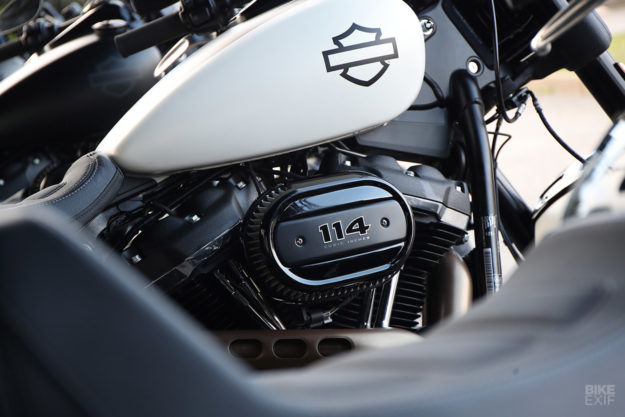
The 45-degree V-twin’s biggest strength is that it delivers power smoother than you’d expect from a big American cruiser, without sacrificing an ounce of character. That smoothness is down to a dual counter-balancer, which also means that the engine can now hang off rigid (rather than rubber) mounts. This makes it a stressed member, adding to the overall flex resistance.
Jumping from the previous ‘high output’ 103 twin cam to the Milwaukee-Eight has also resulted in whopping torque gains. Harley claims that the 107 has 145 Nm and accelerates 10% quicker than the 103. The 114 has 155 Nm, and is 9% quicker still than the 107.
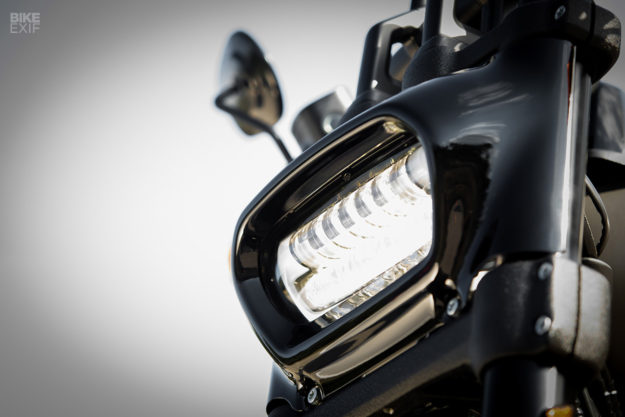
Other new features include Daymaker LED headlights all round, new instruments, and a wet sump that sits lower (the old oil tank had to make way for the under-seat shock). There are also some nice ‘shortcut’ features for customizers, like rear struts that can be unbolted, and a two-part clutch cable.
I was itching to see if all this hard work has paid off—especially since Harley picked an unforgiving proving ground for the launch. We’d be riding four models over two days, over some of the twistiest mountain roads in Spain.
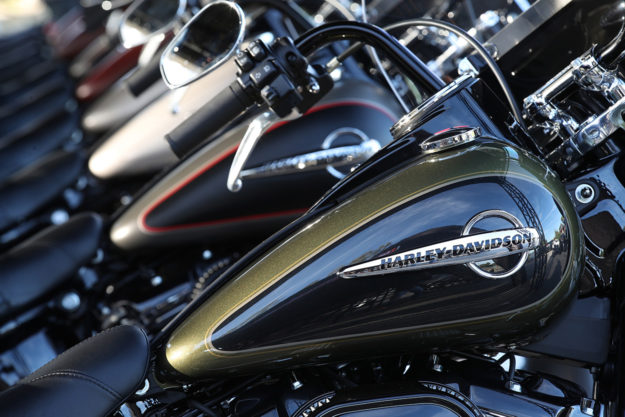
I’ll dig into the details of each bike in a minute, but they all share some pretty universal traits.
For starters, I have to give H-D ten out of ten for build quality and final finish. The paint on each model is deep and flawless, thanks to some pretty rigorous QA processes. Engine and chassis parts sport finishes as diverse as wrinkle black and brushed chrome from model to model, and not a single item looks out of place.
But how do they ride? Paul James, product portfolio manager for the Motor Co., told me he hoped people wouldn’t say that the Softail performs well “for a Harley,” but that its performance would truly impress them.
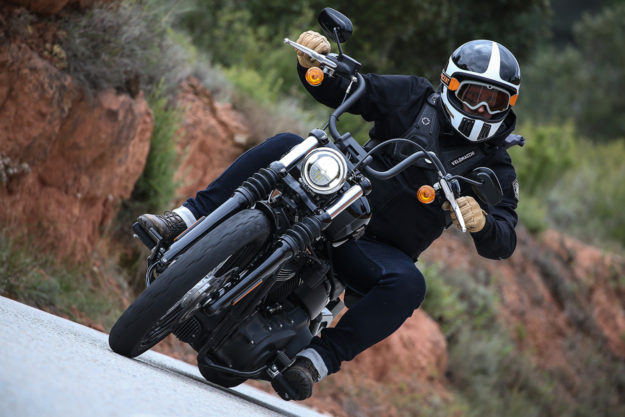
Well, it did truly impress me. And every other guy I rode with.
If I’m honest, percentages of rigidity and performance increases go over my head—I just want a bike that feels good. The old Softail felt vague and spongy in corners, and the Dyna would flex if you pushed it too hard. But the new Softail is surprisingly agile—able to pitch into a corner, hold its line and fire out the other side.
Yes, it’s still a cruiser, so ‘agile’ is relative. And even though each model has improved ground clearance, you’re still eventually going to scrape pegs, footboards and sometimes exhausts.
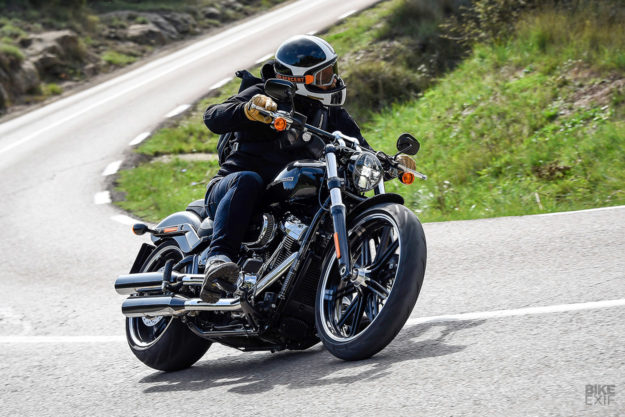
If you’re looking to get a knee down, you’re obviously barking up the wrong tree. But we were riding on tighter and curvier roads than most customers will, at a pace that most customers won’t. And we were all loving it.
The 114 Milwaukee-Eight motor is truly monstrous, and the 107 isn’t far behind. And while big twins are all about torque, both love to be revved, with a slick and predictable throttle and fuelling feel. There’s also just enough of a vibe to stay true to that classic Harley feel, but not so much that I got off with numb hands or missing bolts at the end of the day (it’s happened to me before on the Dyna).

The six-speed box and torque-assist clutch shift easily enough, and I could actually find neutral, which was refreshing.
The brakes and suspension also impressed throughout the range. I seldom touched the rear brake (mostly because on some models I found the lever to be a little hard to reach, and didn’t have time to adjust it), and a couple of fingers on the front was usually enough to slow the bike down.
I mentioned the lack of fork adjustment to Harley’s people, and their reasoning was twofold: they reckon most customers won’t spend time on suspension setup, and the new forks perform well enough not to need it. I can see the logic in the first statement, and after spending miles riding these bikes harder than I should have, I walked away convinced.
So how did each individual model do? I’ll break down the key features of each, then what it was like on the road.
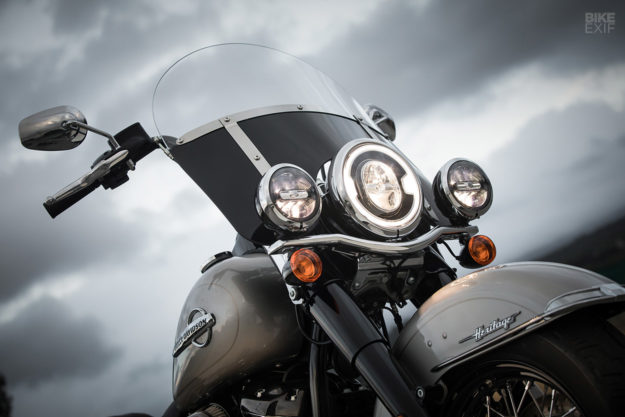
Heritage Classic 114 A traditional cruiser with saddlebags and a screen, the Softail Heritage Classic is the least relevant bike on this list. But that doesn’t mean it isn’t a sweet ride—and a good-looking one too, if that old school, big fender vibe is your thing.
Mine had a lush olive green paint job, surprisingly little chrome, and a mostly blacked-out motor.
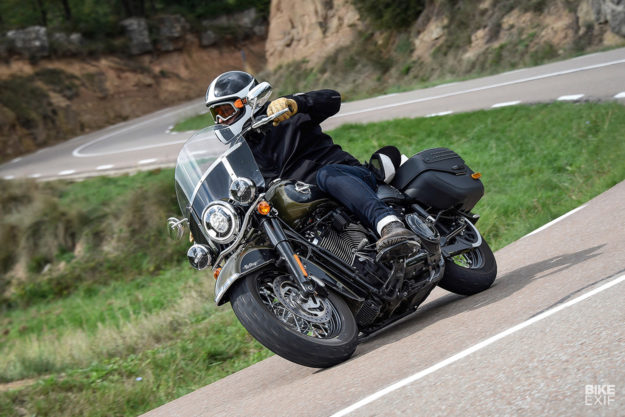
It’s not the sort of bike you’d really customize outside of H-D’s own catalog, but it does feature upgrades like rigid, locking saddlebags, and cruise control. And I have to admit that the new LED lights—and the slick new analog-digital combo dial—are really well executed.
Out on the road, it shunts way quicker than grandpa’s Softail. As laid-back as it looks, it loves to rail turns and scrape floorboards. Sure, I’ll never dream of owning one… but if my retired Harley-loving parents upgrade this year, you can bet I’ll ‘borrow’ it.

Breakout 114 The new Breakout maintains the raked-out drag bike look that made the outgoing model so popular, but in a more modern package. The tank has a low profile from the side, and a killer outline when you’re looking down at it, with sharp corners up front and a taper towards the rider.
H-D were clear that the new Softails should retain as much classic Harley DNA as possible, but still move forward, and the Breakout’s running gear is the epitome of this. The oval LED headlight is inspired by the Livewire, and instead of a traditional speedo, there’s a narrow little digital dash integrated into the top handlebar clamp.
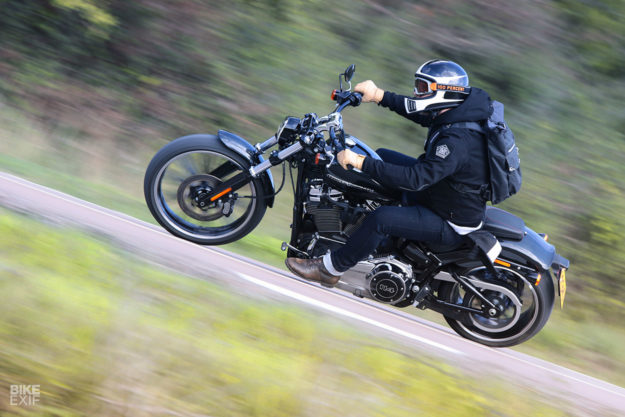
Riding the Breakout is a little weird. For boulevard posing it’s a dream, but with a skinny 21” front wheel and a whopping 240 mm 18” rear, pitching it through turns takes some getting used to. The front finds its line quick, but the rear takes a second to catch up.
It took a few corners to familiarize myself. But once I had the method down I was scraping the forward pegs, occasionally bouncing the exhaust’s heat shield off the black top, and literally laughing into my helmet.
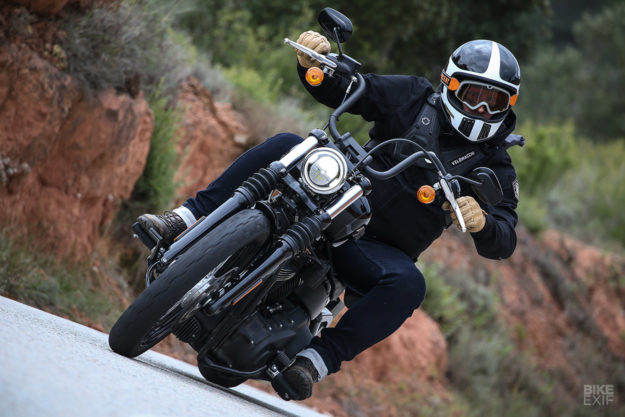
Street Bob Harley-Davidson clearly didn’t want to spoil us too much, so they slipped at least one 107 into the set: the Softail Street Bob. As the cheapest new Softail, it’s the most likely entry point into the new range, and a logical step up for Sportster owners looking to upgrade.
Out the box you get a solo seat, mini ape bars and mid-mounted foot controls. The riding position is frankly bizarre and uncomfortable, but it’s also awkward in a way that makes you feel really cool riding it. I’m six foot tall, so a cruiser with a low seat height and mid pegs normally doesn’t cut it for me. Most guys my height are going to fit forward pegs and adjust the bars right away.
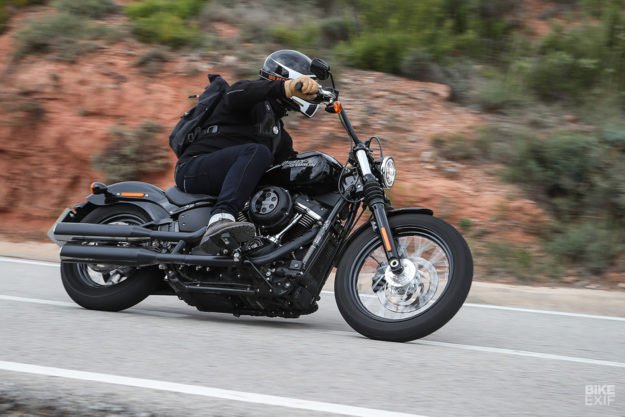
That’s also the Street Bob’s strength. It’s a blank canvas, and the Softail that’s probably going to get the most love from customizers. Plus there’s almost zero chrome on it, and it’s kitted with the same sweet little mini-speedo as the Breakout (finished in black).
It’s the lightest of the new range too, which—combined with its narrow 19F/17R wheel sizes—makes it the most flickable, and a total hoot to ride with those mini apes. Given the option, I’d be hard-pressed to choose between this guy, and the next one on the list.
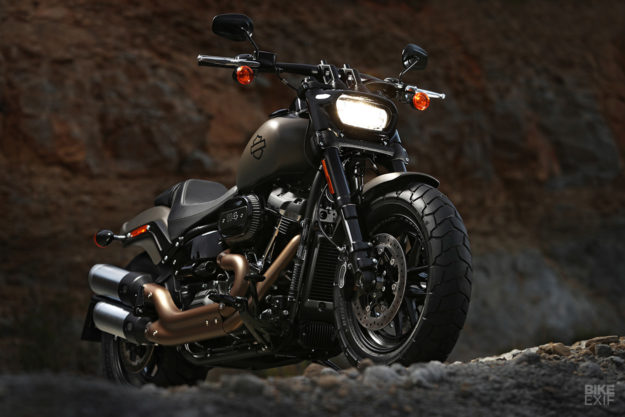
Fat Bob 114 The bike that grabbed the most attention when the range was announced, the Fat Bob 114 is a muscle bike of the highest order. I’m a huge fan of the 2017 Dyna Low Rider S, and as far as I’m concerned, this is the replacement.
Let’s start with the obvious: the Fat Bob’s punch-in-the-face looks. If you think it’s weird and awkward, I’d like to direct you to the outgoing Fat Bob. Satisfied?
There’s not an angle on this bike that I don’t love. The pillbox LED headlight is killer, and so is the raised rear fender, the massive double barrel exhaust system, and the cast wheels. I normally detest drag bars on bike, but these drag bars start wide and taper down to 1”, held in place by beefy cutaway risers that tilt them closer to the rider.
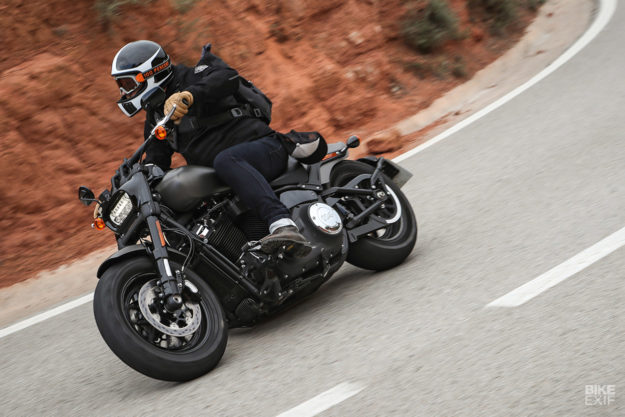
My only gripe is the speedo. I love the analog and digital mash-up, and there’s plenty of information to keep you happy. But I was left pining for the same handlebar-mounted mini-dash as the Street Bob and Breakout.
Looking down at the tank to check speed on a monster motorcycle is less than ideal. (I asked, and swapping the speedo out isn’t possible without serious modifications).
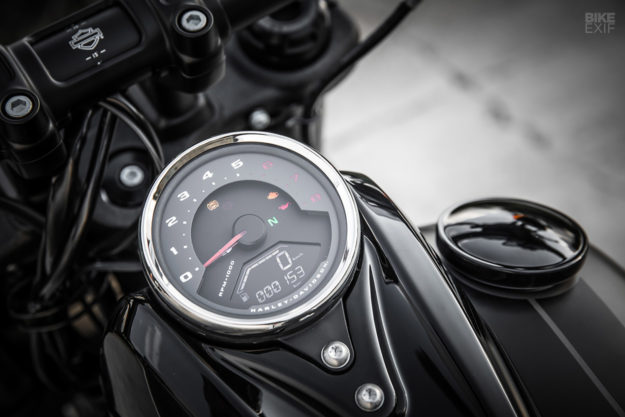
Hooning on the Fat Bob was an epic experience. Harley’s Paul James hopes that this is the bike that will attract sporty riders who are fed up with pukka sportbikes, and he might just be right. It shouldn’t love corners because it’s 676 pounds (306 kg) wet. And it has 16” wheels measuring 150 mm wide up front and 180 mm at the rear. But it does love those corners—provided you’re willing to work for it.
You know how on some rides you just feel a bit off? That was me, the day I hopped on the Fat Bob. But once I’d figured it out I started finding my groove—just in time to swap bikes, sadly.
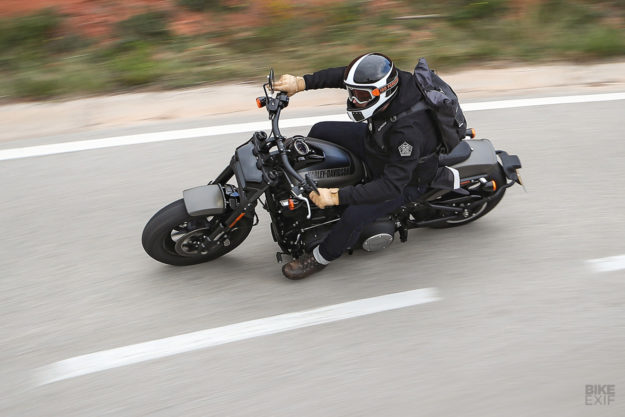
The trick is to counter steer, get your head and shoulders over, and muscle it through. It is hard work. It is tiring. But it’s bags of fun, and I’m aching for another go on a better day.
The Fat Bob is also blessed with the most ground clearance of the range, thick inverted forks offering even more performance, and pegs that are more mid-forward than fully forward. The biggest surprise? It was hands-down the most comfortable of the four.
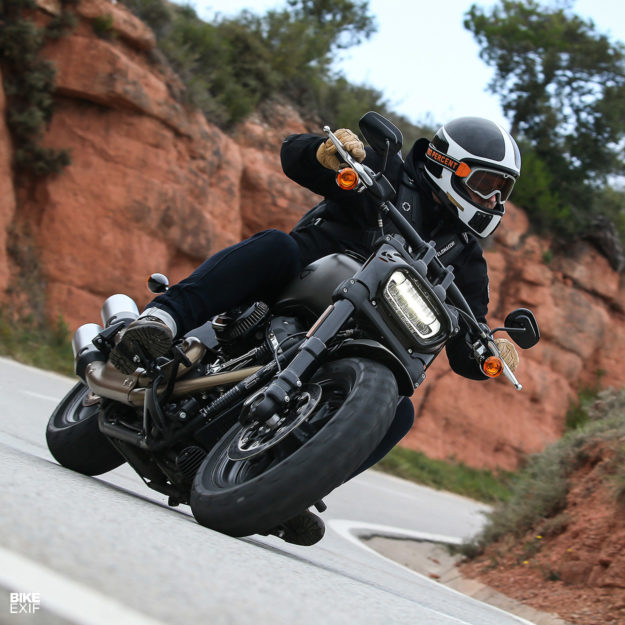
So why are we talking about Softails, when there are more custom Sportsters on these pages than Softails and Dynas combined? It’s pretty simple. Harley-Davidson have said that they’re releasing 100 new models in ten years.
That’s a bold statement, and judging by just how different these new bikes are to their predecessors, they’re taking it pretty seriously.
It also has us thinking about the venerable Sportster. At 60 years old it’s long overdue for a major overhaul. If the Motor Co. was willing to kill off a bike as loved as the Dyna, is it that much of a stretch to imagine a modernized Sportster that lives up to its name?
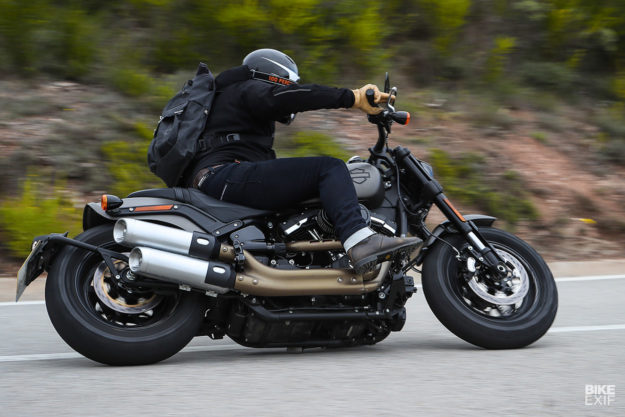
I didn’t like Harleys up until a year ago, but somehow I’ve started to see the appeal. Sure, cruisers aren’t for everyone—but I’m convinced anyone will have a good time on these new Softails.
I asked Bill from Biltwell Inc. for his thoughts, and he said: “The bikes are pretty fantastic in context. We bought a Street Bob last week and are already falling in love with it.” And T-Bone at Noise Cycles was impressed too: “I could definitely roll the new Street Bob, and would be stoked to do my thing with it.”
High praise from guys in the know. Who else is looking forward to seeing what custom builders do with the new Softails?
Base prices in US$ for the new Softail models will be: Street Bob $14,499, Low Rider $14,999, Softail Slim $15,899, Fat Bob $16,999, Deluxe $17,999, Fat Boy $18,999, Heritage Classic and Breakout $18,999.
Harley-Davidson Softail range | Facebook | Instagram
Wes’ gear Rough Crafts ‘Revelator’ helmet | 100% Barstow goggles | REV’IT! Stealth hoody | Aether Apparel Moto gloves | Saint Stretch denim | Stylmartin Red Rock boots | Velomacchi Speedway 28l backpack

